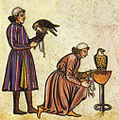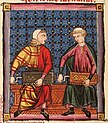1200–1300 in European fashion

Costume during the thirteenth century in Europe was relatively simple in its shapes, rich in colour for both men and women, and quite uniform across the Roman Catholic world as the Gothic style started its spread all over Europe in dress, architecture, and other arts.
Male and female clothing became remarkably similar, with many men's garments differing substantially from women's dress only in hem length, with the fanned sleeves common in the previous century vanishing from the latter and tightly buttoned sleeves becoming common.[1] While most items of clothing, especially outside the wealthier classes, remained by comparison little changed from three or four centuries earlier,[2] the more tightly shaped cuts that had been introduced in the preceding century continued to evolve in commoners' fashion[3] too, with the imitation of nobles' clothing beginning among the developing burgher class that would become prominent in following centuries.
The century saw great progress in the dyeing and working of wool, which was by far the most important material for outerwear. For the rich and fashionable, vibrant colour and rare fabrics such as silk from the
The most common dyes remained shades of red, notably
Men's clothing
Men wore a
Working men's clothing
Working men wore a short coat, or tunic, with a belt. It was slit up the center of the front so that they could tuck the corners into their belt to create more freedom of movement. They wore long braies or leggings with legs of varying length, often visible as they worked with their cotte tucked into their belt. Hose could be worn over this, attached to the drawstring or belt at the waist. Hats included a round cap with a slight brim, the beret (just like modern French ones, complete with a little tab at the top), the coif (a little tight white hood with strings that tied under the chin), the straw hat (in widespread use among farmworkers), and the chaperon, then still a hood that came round the neck and over the shoulders. Apart from aprons for trades like smithing, and crude clothes tied round the neck to hold seed for sowing, special clothes were not worn for working.[6]
Style gallery
-
1 – Work clothes
-
2 – Shirt
-
3 - Tunics
-
4 – Tunics and mantles
-
5 – Cappa or chaperon
-
6 - Tunics
-
7 - Tunics with hanging sleeves
- Maciejowski Bible, c. 1250. The man on the left wears green hose over his braies.
- Man in a coif and shirt (camisa) with gussets at the hem, from the Cantigas de Santa Maria, Spain, mid-13th century.
- Falconers wear belted tunics and coifs, 1240s.
- Prophetia Merlini, c. 1250–70.
- Man in the short, hooded cape called a cappa or chaperon, c. 1250–70.
- Musicians wear two long tunics, one over the other. The tunic on the left is an early example of mi-parti or particolored clothing, made from two fabrics. Cantigas de Santa Maria, mid-13th century, Spain.
- Pan-pipe players wear tunics with hanging sleeves over long-sleeved undertunics. Both wear coifs. Cantigas de Santa Maria, mid-13th century, Spain.
Women's clothing

Overview
Dress for women was more loosely fit compared to the previous century and somewhat more modest, the era from about 1220 onward having notably been characterised as the 'elegant period' in Gothic dress by Ortwin Gamber.
A narrow belt was uniform, which could be richly decorated with metal plating in various colours such as gold and green. Over it was worn the cyclas or sleeveless surcoat also worn by men. More wealthy women wore more embroidery and their mantle, held in place by a cord across the chest, might be lined with fur. Women, like men, wore hose and leather shoes which, like men's shoes, could be elaborately embroidered for special occasions.[5]
Headdresses and hairstyles
Individuality in women's costume was notably expressed through their hair and headdress. One distinctive feature of women's headwear was the
Women also wore long tunics that went down to their ankles. This was worn over a shirt.Wealthier women's jewelry
Wealthy women often wore clothes lined with fur. They wore jewelry and jewels such to make them look wealthy. Rings and brooches were made of gold and silver, inset with uncut precious and semi-precious stones. Gold was reserved for the upper class.
Style gallery
Sumptuary laws
The
These probably reflected both a growing concern for control over the increasing urban populations, and the increasing effectiveness of the Church's control over social issues across the continent.
Footwear
Shoes began to develop a pointed toe at this time however, they were much more restrained than they were in the 14th century. The usual shoe, worn by men and women alike, opened at the front, from the instep to the toe. Boots were largely only worn by men. Commoners also wore stockings with leather sewn to the sole, and wooden clogs. Woollen garters were also worn by commoners.[10]

References
- ISBN 0486290603.
- ISBN 0-300-06906-5
- ^ ISBN 9783935616003.
- ^ Piponnier & Mane, op cit, p. 60
- ^ a b c Payne, Blanche: History of Costume from the Ancient Egyptians to the Twentieth Century, Harper & Row, 1965
- ^ Piponnier and Mane, op cit pp. 49–52
- ISBN 0-300-06906-5. Seals from Norman Roth, op cit. Also Schreckenburg p. 15 & passim.
- ^ Medieval Jewish History: An Encyclopedia. Edited by Norman Roth, Routledge Archived 2008-02-25 at the Wayback Machine
- ^ Piponnier and Mane:139–141
- ^ Hughes, Talbot (1920). Dress design: An Account of Costume for Artists & Dressmakers. LONDON: PITMAN & SONS. pp. 80–82.
Further reading
- Black, J. Anderson, and Madge Garland: A History of Fashion, 1975, ISBN 0-688-02893-4
- ISBN 0-8109-1693-2.
- Crowfoot, Elizabeth, Frances Prichard and Kay Staniland, Textiles and Clothing c. 1150 – c. 1450, Museum of London, 1992, ISBN 0-11-290445-9
- Kohler, Carl: A History of Costume, Dover Publications reprint, 1963, ISBN 0-486-21030-8
- Koslin, Désirée and Janet E. Snyder, eds.: Encountering Medieval Textiles and Dress: Objects, texts, and Images, Macmillan, 2002, ISBN 0-312-29377-1
- Kybalová, Ludmila, Olga Herbenová, and Milena Lamarová: Pictorial Encyclopedia of Fashion, translated by Claudia Rosoux, Paul Hamlyn/Crown, 1968, ISBN 1-199-57117-2
- Laver, James: The Concise History of Costume and Fashion, Abrams, 1979
- Payne, Blanche: History of Costume from the Ancient Egyptians to the Twentieth Century, Harper & Row, 1965. No ISBN for this edition; ASIN B0006BMNFS








